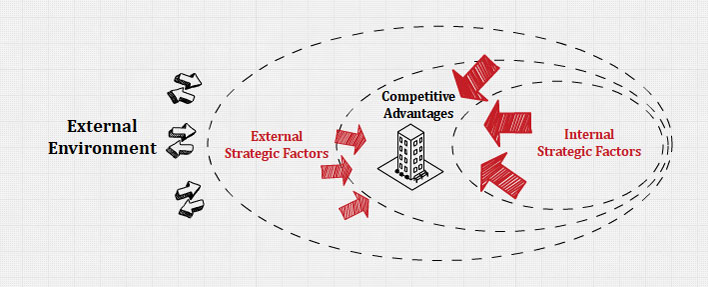What is Resource-Based View?
Resource-based view proposes that internal strategic factors play a more critical role than external strategic factors in developing the firm’s competitive advantage. It assumes that each organization is a collection of unique resources and capabilities. The uniqueness of its resources and capabilities is the basis of a firm’s strategy and its ability to earn above-average returns.
According to the resource-based model, differences in firms’ performances across time are due primarily to their unique resources and capabilities rather than the industry’s structural characteristics. This model also assumes that firms acquire different resources and develop unique capabilities based on how they combine and use the resources; that resources and certainly capabilities are not highly mobile across firms; and that the differences in resources and capabilities are the basis of competitive advantage. Through continued use, capabilities become stronger and more difficult for competitors to understand and imitate. As a source of competitive advantage, a capability must not be easily imitated but also not too complex to understand and manage.
Understand Resource-Based View (RBV)

The resource-based view (RBV) contends that the possession of strategic resources provides an organization with a golden opportunity to develop competitive advantages over its rivals.
A strategic resource is a resource that is rare, difficult to imitate, and non-substitutable. A strategic resource is valuable to the extent that it helps a firm create strategies that can capitalize on opportunities and ward off threats, thus create its competitive advantages. These competitive advantages in turn can help the organization enjoy strong profits.
The resource-based view (RBV) contends that internal resources are more important for a firm than external factors in achieving and sustaining competitive advantage.
In a world where customer preferences are volatile, the identity of customers is changing, and the technologies for serving customer requirements are continually evolving, and externally focused orientation does not provide a secure foundation for formulating a long-term strategy.
When the external environment is in this state of flux, the firm’s own resources and capabilities may be a much more stable basis on which to define its identity. Hence, a definition of a business in terms of what it can do may offer a more durable basis for strategy than a definition based upon the needs which the business seeks to satisfy.
The basic premise of the RBV is that the mix, type, amount, and nature of a firm’s resources should be considered first and foremost in formulating strategies. Firms must develop and exploit their strategic resources and capabilities, and continually maintain and strengthen these, in order to position their strategies.
When a firm can pursue a strategy that is based on its strategic resources, there is a high chance that strategy is not currently being implemented by any competing firms. When other firms are unable to duplicate a particular strategy, then the focal firm now can have a competitive advantage and enjoy profits that may come with it.
The resource-based view has evolved in recent years to provide a way to understand how strategic resources and capabilities allow firms to enjoy excellent performance.
It builds on past ideas about resources, but it represents a big improvement on past ideas in at least two ways. First, the resource-based view offers a complete framework for analyzing organizations, not just snippets of valuable wisdom. Second, the ideas offered by the resource-based views have been developed and refined through scores of research studies involving thousands of organizations.
Understanding both external and internal factors, and more importantly, understanding the relationships among them, will be the key to effective strategy formulation. The resource-based view has continued and will continue to grow in popularity and seek a better understanding of the relationship between resources and sustainable competitive advantage in strategic management.
Beyond RBV: Other Views on Internal Organization

Each of these 3 following theories is useful for understanding some situations and some important business decisions.
They are: (1) enactment, (2) environmental determinism, and (3) transaction cost economics.
Enactment treats the firm’s executives as the masters of their domains.
Enactment contends that an organization can, at least in part, create an environment for itself that is beneficial to the organization. This is accomplished by putting strategies in place that reshape competitive conditions in a favorable way.
Environmental determinism views organizations much like biological theories view animals.
Organizations (and animals) are very limited in their ability to adapt to the conditions around them. Thus just as harsh environmental changes are believed to have made dinosaurs extinct, changes in the business environment can destroy organizations regardless of how clever and insightful executives are.
Transaction cost economics is a theory that centers on whether it is cheaper for a firm to make or to buy the products that it needs.
This is an important element, however, because choosing the more efficient option can enhance a firm’s profits.
However, RBV still stands as perhaps the most popular theory of why some organizations prosper while others do not.
Only RBV currently does a good job of explaining firm performance across a wide variety of contexts. Thus it offers the point of view of business that has the strongest value for most executives.